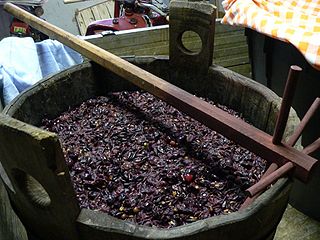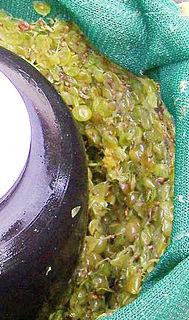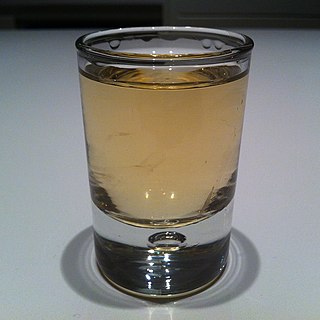
Brandy is a spirit produced by distilling wine. Brandy generally contains 35–60% alcohol by volume and is typically drunk as an after-dinner digestif. Some brandies are aged in wooden casks. Others are coloured with caramel colouring to imitate the effect of aging, and some are produced using a combination of both aging and colouring. Varieties of wine brandy can be found across the winemaking world. Among the most renowned are Cognac and Armagnac from southwestern France.

Tsipouro is a un-aged brandy from Greece and in particular Thessaly, Epirus, Macedonia, and the island of Crete. Tsipouro is a strong distilled spirit containing 40–45% alcohol by volume and is produced from either the pomace or from the wine after the grapes and juice have been separated. It comes in two types: pure and anise-flavoured and its usually not aged in barrels, although barrel aged versions do exist.

Fanta is a brand of fruit-flavored carbonated drinks marketed globally created by The Coca-Cola Company. There are more than 100 flavors worldwide. Fanta originated as a Coca-Cola substitute during the American trade embargo of Nazi Germany which affected the availability of Coca-Cola ingredients in 1940.

Must is freshly crushed fruit juice that contains the skins, seeds, and stems of the fruit. The solid portion of the must is called pomace and typically makes up 7–23% of the total weight of the must. Making must is the first step in winemaking. Because of its high glucose content, typically between 10 and 15%, must is also used as a sweetener in a variety of cuisines. Unlike commercially sold grape juice, which is filtered and pasteurized, must is thick with particulate matter, opaque, and comes in various shades of brown and purple.
Rakia or rakija is the collective term for fruit brandy popular in the Balkans. The alcohol content of rakia is normally 40% ABV, but home-produced rakia can be stronger.

Pomace, or marc, is the solid remains of grapes, olives, or other fruit after pressing for juice or oil. It contains the skins, pulp, seeds, and stems of the fruit.

Pomace brandy is a liquor distilled from pomace that is left over from winemaking, after the grapes are pressed. It is called marc in both English and French, but "grappa" in Italian. In Spain it is sometimes called marc, but more usually orujo. Alcohol derived from pomace is also used as the traditional base spirit of other liquors, such as some anise-flavored spirits. Unlike wine brandy, most pomace brandies are neither aged nor coloured.

Grappa is an alcoholic beverage: a fragrant, grape-based pomace brandy of Italian origin that contains 35 to 60 percent alcohol by volume.

An eau de vie is a clear, colourless fruit brandy that is produced by means of fermentation and double distillation. The fruit flavor is typically very light.

Olive oil extraction is the process of extracting the oil present in olive drupes, known as olive oil. Olive oil is produced in the mesocarp cells, and stored in a particular type of vacuole called a lipo vacuole, i.e., every cell contains a tiny olive oil droplet. Olive oil extraction is the process of separating the oil from the other fruit contents. It is possible to attain this separation by physical means alone, i.e., oil and water do not mix, so they are relatively easy to separate. This contrasts with other oils that are extracted with chemical solvents, generally hexane. The first operation when extracting olive oil is washing the olives, to reduce the presence of contaminants, especially soil which can create a particular flavor effect called "soil taste".

Zivania or zivana is a Cypriot pomace brandy produced from the distillation of a mixture of grape pomace and local dry wines made from Xynisteri and Mavro grapes.Zivania is colourless and alcoholic with a light aroma of raisins. Its alcohol content varies, with 45% by volume being the typical value. Zivania contains no sugars and has no acidity.

Orujo is a pomace brandy from northern Spain. It is a transparent spirit with an alcohol content over 50%. Its name comes from the expression "aguardiente de orujo".

Tsikoudia, also often called raki in the eastern part of Crete, is an alcoholic beverage, a fragrant, grape-based pomace brandy of Cretan origin that contains 40% to 65% alcohol by volume. Tsikoudia is made by distilling of pomace, what remains of grapes pressed in winemaking. The pomace ferments for about six weeks in a tightly-sealed barrel, and is then distilled.

A press cake or oil cake is the solids remaining after pressing something to extract the liquids. Their most common use is in animal feed.

Chacha is a Georgian pomace brandy, a clear and strong, which is sometimes called "vine vodka", "grape vodka", or "Georgian vodka/grappa". It is made of grape pomace. The term chacha is used in Georgia to refer to grape distillate. It may be also produced from unripe or wild grapes. Other common fruits or herbs used are figs, tangerines, oranges, mulberries or tarragon.

Maslinic acid is a compound derived from dry olive-pomace oil which is a byproduct of olive oil extraction. It is a member of the group of triterpenes known as oleananes.
Fruit brandy or fruit spirit is a distilled beverage produced from mash, juice, wine or residues of edible fruits. The term covers a broad class of spirits produced across the world, and typically excludes beverages made from grapes, which are referred to as plain brandy or pomace brandy. Apples, pears, apricots, plums and cherries are the most commonly used fruits.
Trnavac is a small village in Serbia situated in the municipality of Zajecar, in the Timok District, eastern Serbia.
Olive pomace oil is olive oil that is extracted from olive pulp after the first press. Once the mechanical oil extraction of olive oil is complete, approximately 5–8% of the oil remains in the pulp, which then needs to be extracted with the help of solvents, an industrial technique used in the production of most other edible oils including canola, peanut, sunflower, etc. Although the oil extracted in this manner is still olive oil, at retail it may not simply be called “olive oil”. This is because the International Olive Council defines olive oil as “the oil obtained solely from the fruit of the olive tree, to the exclusion of oils obtained using solvents or re-esterification processes”

Coutaric acid is a hydroxycinnamoyltartaric acid found in wine, pomace and grape. It is an ester formed from coumaric acid and tartaric acid.

















